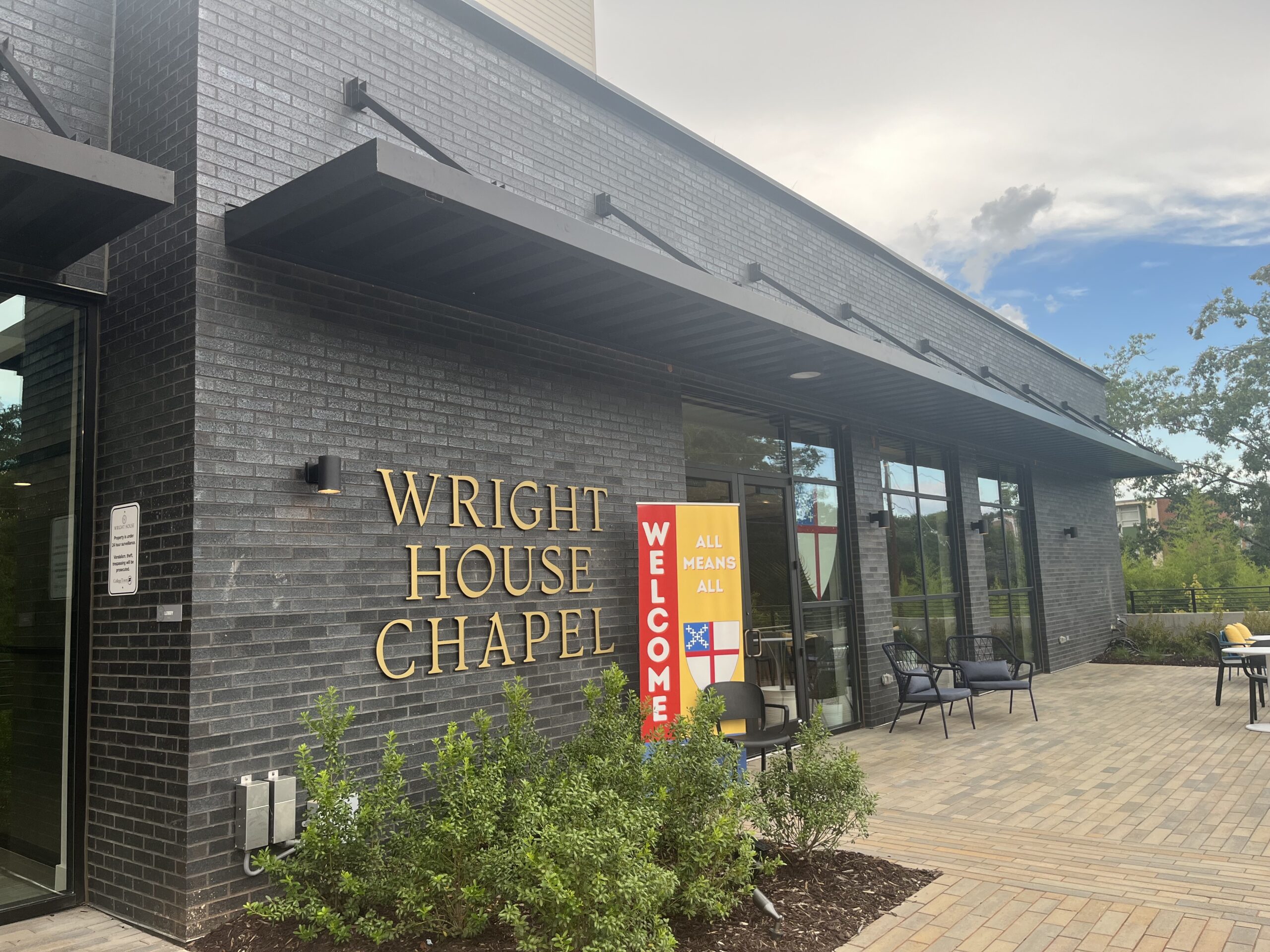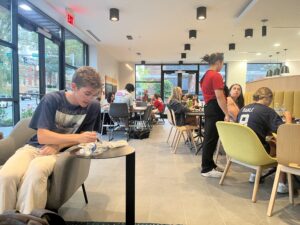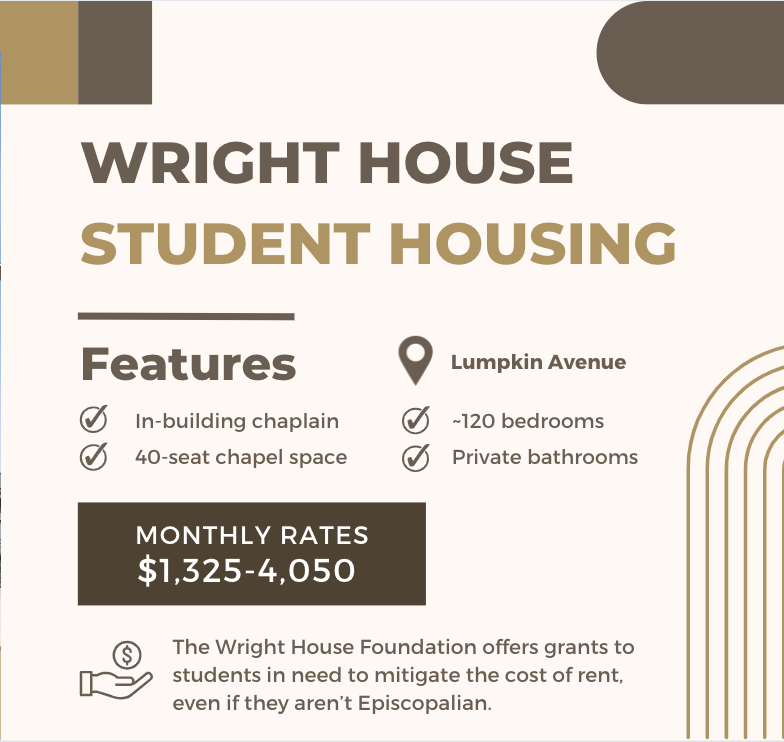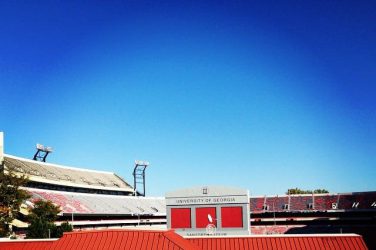Editor’s note: Faith on Lumpkin is a series produced by students in the fall 2023 Religion Reporting class. They were embedded with four student religious groups — UGA BCM (Baptist Collegiate Ministries), Christus Victor Lutheran Church and Student Center, the Presbyterian Student Center, the Episcopal Campus Ministry — that have physical locations on Lumpkin Street to learn about the faith, meet student and non-student leaders, identify newsworthy stories, and ultimately produce a multiplatform feature story out of their ongoing coverage.
Katie Sue Martin-Williams grew up in the Christian faith. At the end of her first year at the University of Georgia, she had to decide where she would live next — a place that ended up not only being where she lives, but where she worships, too.
Her mom suggested she live at the Wright House, a new complex on the corner of Lumpkin Avenue and University Court.
“I think she just liked the idea that I’d be living in a Christian living space,” Martin-Williams said.
The Wright House, however, is not a religious living space — it’s something unique to UGA and many college campuses.
The Episcopal Diocese of Atlanta and a group of architects and financial backers broke ground on the $20 million Wright House Project in 2020, transforming a modest blue church surrounded by trees into a modern student housing complex.
Residents live in the approximately 120 bedrooms above, separate from the chapel, but built on a physical foundation of faith. A part of its ground floor remains home to UGA’s Episcopal Campus Ministry.
‘Live, Study, Pray’
The vision for the Wright House is to be a space where students can “live, study, pray,” according to the Rev. Lang Lowrey, who oversees the diocese’s Christian enterprise efforts, and the Rev. Clayton Harrington, who is the chaplain of the Wright House and ECM’s campus minister.
“We don’t want to force anyone into any of the three,” Harrington said. “If you’re going to live here, you have to choose it. If you’re going to study here, you have to choose it. And if you want to pray here, you’re going to choose that as well.”
The function of the Wright House student housing, operated by CollegeTown Properties through a land lease, and ECM, which is operated by the diocese, are separate.
However, there are agreements to encourage Episcopalian students to live there. The Wright House Foundation offers financial assistance to students to offset the cost of living.
Harrington said even with the grant, Episcopalian students were hesitant to move into the uncertainty of the building when it opened in August 2022. But interest in living at the Wright House is growing among the congregation, he said.
Sophomore political science and history major Ian Roberts arrived at UGA when the first students were moving into the Wright House.
“I am actually trying to apply to live here,” Roberts said. “Many of the rooms that are here are actually filled up, so it’s been a hassle trying to wait it out for availability, but I’m still waiting.”
No members of the student vestry, a small group that plans events and works on student engagement, live in the Wright House, Roberts said. However, some residents will come to ECM events — especially on Wednesdays.
ECM hosted its congregation, which varies in size between 10 and 40 students, depending on the service, and Wright House residents for Dinner and Compline, a brief evening prayer, on Wednesday nights this semester.
Dinners are in the lounge, a space on the ground floor meant for studying and socializing. It is separate from the chapel and apartments, a common ground regardless of religion. Usually between 40 and 50 people come to get the free dinner, more than half of whom are residents, Harrington said.
This weekly gathering is the only consistent overlap between the communities. Some residents take food to their rooms, while others stay to socialize or just swing by to pet Harrington’s standard poodle, Nova. Harrington and Nova live in a private unit in the Wright House.
Often, residents will be in the lounge when Wednesday dinner begins, like current Wright House resident Martin-Williams and former resident Tara Powell on a recent weeknight during the fall semester.
Although Martin-Williams is Presbyterian, she only goes to ECM — not the Presbyterian Student Center down the street. Powell, a junior advertising major who is Catholic, chose to go to the Catholic Center up the street.
When she lived in the Wright House, Powell said that people had a lot of questions.
“Most people that I talked to about it when I did live here were like, ‘Oh my God, is that, like, religious? There’s a church under it,’” Powell said. “It’s just a church there. It doesn’t disrupt anybody.”
Martin-Williams, a junior public relations major, even faced questions from the resident assistant in her former dorm.
“A lot of people wonder if a requirement to live here is that you’re Christian, which is not true — we had a Muslim roommate,” Martin-Williams said. “And then my RA from last year asked me if I was allowed to drink and have sex. I’ve read the lease thoroughly, and there’s nothing to do with religion.”
Chapel as an Amenity
The Wright House’s early success has raised the question of whether or not other campus ministries, such as others on Lumpkin Street, may do the same thing in the future.
There are no tax loopholes through ventures like this, said Athens-Clarke County Chief Tax Appraiser Kirk Dunagan.
“The chapel and the chaplain’s apartment are tax exempt, but the rest of the property is not,” Dunagan said.
Darren Hayunga, an associate professor of real estate at UGA, said in an interview that the Wright House is a unique venture. While Harrington described the chapel as an “amenity,” Hayunga doubts it has much impact — positive or negative — on the property value.
“The chapel is a close neighbor, like a dry cleaner,” Hayunga wrote in an email. “Unlike a street-level dry cleaner or other retail store, it can be expected that fewer students will gain utility from the chapel since approximately (1%) of the U.S. population are practicing Episcopalians.”
The importance of the Wright House transcends the physical space for ECM students.
“Our main goal is to love everyone like Jesus,” Roberts said. “That’s very much a part of (ECM) and of the Episcopal tradition as a whole.”
Harrington said he wishes there were more Episcopalians in the building to connect the two communities. It’s a goal.
“One of the fun things about being a campus minister is that you can take risks,” he said. “You can do experiments and this has been a big experiment, but one I think has been successful.”
Martina Essert and Cole Underwood are fourth-year journalism majors.













Show Comments (0)